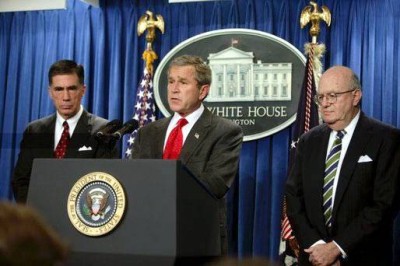Taking another look through the scope at American Sniper
To quote Ronald Reagan, “There you go again.”
The “you” in this instance is the Republican Party. It’s the GOP’s penchant for trying to fudge history to cover more Republican tracks. Now the Grand Oil Party wants to blur what happened when the Cheney/Bush Administration cajoled us into invading Iraq.
Mushroom cloud and WMD rhetoric was strictly in vogue then. It worked. The US did invade Iraq and the evil Saddam Hussein. Whoops, things didn’t go as well as Donald Rumsfeld planned.

Well, it’s not only time to go again — as President Reagan was wont to say — but put a new surface on the folly of Iraq. In a recent Wall Street Journal opinion piece, Federal Judge Laurence Silberman attempts to shore up the cultural tidal wave that is American Sniper. You know, the movie directed by Clint Eastwood about the late Chris Kyle? The only things bigger than the box office of American Sniper are the legs this movie has grown since I reviewed it a month ago.
Many are not complaining, like I have been, that American Sniper gives the Bush II Administration a pass on the war for which Navy Seal Chris Kyle shot dead so many enemies of America. Chris Kyle didn’t get us into that war; he was doing his job, whether any of us like the idea of what some of his tasks entailed. We’ve known, since at least our Civil War, that “War is hell.”
A couple of blaring points in my review of American Sniper state that character motivation in the script is lame in two places for two main characters: Kyle and his wife. Mrs. Kyle becomes terribly upset about her husband’s progressive PTSD due to several Iraqi tours. However, as suddenly as a bullet might whiz by one’s ear in heavy combat, she’s okay with it. No problem … and nothing from the script as to why her attitude changes.
The other flawed motivation the screenplay allows is Kyle’s apparent recovery or partial recovery from PTSD. The film suggests that Kyle was able to heal because he finally began to aid other returning Iraqi vets with PTSD, as he was doing with Eddie Ray Routh on a Texas gun range when Routh shot and killed Kyle and another person. Problem is, the movie has Kyle’s healing process move almost as fast as another round whizzing by your other ear.
But American Sniper isn’t a short motion picture at all. Its running time is two-hours and fourteen minutes. Clint Eastwood gives you an extended battle scene — well-staged and produced — that comes near the close of the movie. I think the reason for motivational changes depicted in Kyle and his wife are important to the story and should have taken up a longer portion of American Sniper. The battle scene didn’t help, although it might’ve engendered more appeal for moviegoers who enjoy really awful conflict in a really awful war into which — and in reality — Americans were sucked.
Now and again, Progressives use the term “The Reagan/Bush Legacy.” So it might be worth a mention that Judge Laurence Silberman was nominated to the Federal Bench in 1985 by Ronald Wilson Reagan.
I wonder how well the resurfacing of the 2003 Iraq invasion will go for the GOP. I also wonder if the job has been started early enough for the 2016 presidential campaign and election.
My original review of American Sniper is here.
- Movie Review: ‘The Glorias’ - September 28, 2020
- Movie Review: ‘I’m Thinking of Ending Things’ - September 10, 2020
- Movie Review: ‘The Burnt Orange Heresy’ - August 31, 2020

